

|
|
|
|
|
|
|
|
|
|
|
|
|
|
|
|
|
| A. Terrill Brothers | E. Simon Cameron | I. Benjamin Franklin Butler |
| B. Joseph Johnston | F. Ulysses S. Grant | J. Nathan Bedford Forest |
| C. Salmon P. Chase | G. Robert Toombs | K. Robert E. Lee |
| D. Abraham Lincoln | H. Richard C. Page | L. Judah P. Benjamin |
____ 1. What Cavalry general said his philosophy was "War means fightin' and fightin' means killing.
____ 2. Whose tombstone reads "Here lie my two sons. Only God knows which was right."
____ 3. What politician never asked for a pardon after the war, commenting, "Pardon for what? I haven't pardoned you all yet."
____4. A newspaper editor, said about him, "The only thing he wouldn't steal is a red-hot stove!"
____5. Who said, "I am trying to evade the butchering business lately."
____6. Who commented, "I would rather people wonder why I wasn't president than why I was"?
____7. Who said, "The reason Sumner doesn't believe in the Bible is that he didn't write it himself."
____8. Who said, "The shot that struck me down was the best ever fired in the Confederacy."
____9. When John Pope announced that his headquarters would be in the saddle, who quipped, "He has his headquarters where his hindquarters should be"?
____10. Who said, "I'm prepared to sacrifice life and will only surrender when I have no means of defense"
13 How well do you remember 1861? Match the month (January = A, December = 12) with the event:
____1. Battle of Wilson's Creek; Nathaniel Lyon is killed; McClellan commands Army of Potomac.
____2. Battle of Santa Rosa, Florida; Western Union completes first transcontinental telegraph.
____3. Mississippi and Florida secede. Union captures Fort Taylor, Key West.
____4. Arkansas secedes; Robert E. Lee commands Army of Northern Virginia.
____5. Abraham Lincoln leaves Springfield, Illinois; Jefferson Davis elected Provisional President of the Confederate States of America.
____6. Mason and Slidell, on British steamer "Trent," arrested by USN Capt. Wilkes; McClellan "stiffs" Lincoln and Seward and goes to bed.
____7. Lincoln orders US Navy to blockade Southern ports; Robert E. Lee resigns USA commission.
____8. On Friday before Inauguration, Mr. and Mrs. Lincoln attend "Hamlet" starring Edwin Booth; Missouri rejects secession.
____9. Jefferson Davis is 53; Stephen A. Douglas dies at 48; first use of telegraph in Civil War.
____10. First naval engagement: USS Colorado fights past CSA batteries in Pensacola to sink CSA raider, "Judah;" Only woman officer, Capt. Sally L. Tompkins to head Robertson Hospital in Richmond.
____11. Mason and Slidell released; John C. Breckinridge removed from U. S. Senate 36-0.
____12. Lincoln's first message to Congress; Davis praises Beauregard for victory at Blackburn's Ford, "God be praised for your successful beginning." First Manassas occurs three days later.
14. True or false?
____1. CSS "Chattahoochee" sunk in Chattahoochee River.
____2. Maximum weight that can be borne by pontoon bridge is 7,865 pounds.
____3. No U. S. laws were allowed to remain in force in CSA.
____4. On Dec. 28, 1864, Congress passed a law prohibiting racial discrimination by US Post Offices in their hiring practices.
15. It's on the map! Match the City with the question:
A. New Orleans B. Nashville C. Chicago D. Savannah E. Baltimore F. New York City
1. What City's mayor said his City would be "free city" trading with North and South?
2. What was Confederacy's largest city?
3. What City flooded rice paddies to cut off roads into the city?
4. What city shut down newspapers for pro-Southern statements?-
5. What City, angered at Lincoln's call for troops, cut off telegraph lines to Washington, D. C. and tore up some railroad tracks?
6. What City burned 30,000 pounds of bacon and ham when it was evacuated in February 1863?
End of In"QUIZ'itive - answers at the end
Your editor notes that the METROPOLITAN MUSEUM OF ART, New York City, is holding a special exhibit, 'Photography and the Civil War" through September 2, 2013. Few of us will be able to see these 200 pictures in the flesh, but the following is a fair sample of the first war to be photographed extensively.
 Better
known for his later views commissioned by the Union Pacific Railroad, A.
J. Russell, a captain in the 141st New York Infantry Volunteers, was one
of the few Civil War photographers who was also a soldier. This view of
a slave pen in Alexandria guarded, ironically, by Union officers shows
Russell at his most insightful; the pen had been converted by the Union
Army into a prison for captured Confederate soldiers.
Better
known for his later views commissioned by the Union Pacific Railroad, A.
J. Russell, a captain in the 141st New York Infantry Volunteers, was one
of the few Civil War photographers who was also a soldier. This view of
a slave pen in Alexandria guarded, ironically, by Union officers shows
Russell at his most insightful; the pen had been converted by the Union
Army into a prison for captured Confederate soldiers.
Between 1830 and 1836, at the height of the American cotton market, the District of Columbia, which at that time included Alexandria, Virginia, was considered the seat of the slave trade. The most infamous and successful firm in the capital was Franklin & Armfield, whose slave pen is shown here under a later owner's name. Three to four hundred slaves were regularly kept on the premises in large, heavily locked cells for sale to Southern plantation owners. According to a note by Alexander Gardner, who published a similar view, "Before the war, a child three years old would sell in Alexandria, for about fifty dollars, and an able-bodied man at from one thousand to eighteen hundred dollars. A woman would bring from five hundred to fifteen hundred dollars, according to her age and personal attractions."
Late in the 1830s Franklin and Armfield, already millionaires from the profits they had made, sold out to George Kephart, one of their former agents. Although slavery was outlawed in the District in 1850, it flourished across the Potomac in Alexandria. In 1859, Kephart joined William Birch, J. C. Cook, and C. M. Price and conducted business under the name of Price, Birch & Co. The partnership was dissolved in 1859, but Kephart continued operating his slave pen until Union troops seized the City in 1861.
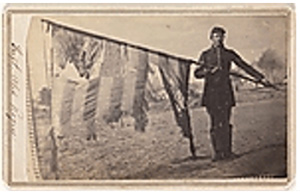 This
unusual horizontal carte de visite a period copy of a now-lost
ambrotype or tintype—shows Sergeant Alex Rogers proudly posing for the
camera holding the scarred colors, or flag, of the Eighty-third
Pennsylvania Volunteers. He and his fellow soldiers fought on virtually
every Eastern battlefield and suffered the second highest number of
battle deaths of any Union regiment. As seen here, infantry flags were
large-more than six feet in length-and affixed to staffs almost 10 feet
tall that made them easy to rally around during a battle. Their size,
however, made them targets for enemy fire and contributed to the high
mortality rate of color bearers.
This
unusual horizontal carte de visite a period copy of a now-lost
ambrotype or tintype—shows Sergeant Alex Rogers proudly posing for the
camera holding the scarred colors, or flag, of the Eighty-third
Pennsylvania Volunteers. He and his fellow soldiers fought on virtually
every Eastern battlefield and suffered the second highest number of
battle deaths of any Union regiment. As seen here, infantry flags were
large-more than six feet in length-and affixed to staffs almost 10 feet
tall that made them easy to rally around during a battle. Their size,
however, made them targets for enemy fire and contributed to the high
mortality rate of color bearers.
 Civil
War soldiers traveled with their units from home to battle-field and,
with some luck, back home bearing on their backs all that they needed to
survive. Many carried precious family photo- graphs and letters as well
as a few rudimentary personal effects such as a sewing kit, pipe, diary,
or deck of playing cards While this game board theoretically could have
been used by a Union soldier at a camp on the front lines, its
construction and pristine condition suggest it was created, sold, and
reserved for patriotic use at home; The playing surface is composed of
one large albumen silver print copy of a grid of photographs of thirty
one Union generals surrounding a portrait of
President Abraham Lincoln.
Civil
War soldiers traveled with their units from home to battle-field and,
with some luck, back home bearing on their backs all that they needed to
survive. Many carried precious family photo- graphs and letters as well
as a few rudimentary personal effects such as a sewing kit, pipe, diary,
or deck of playing cards While this game board theoretically could have
been used by a Union soldier at a camp on the front lines, its
construction and pristine condition suggest it was created, sold, and
reserved for patriotic use at home; The playing surface is composed of
one large albumen silver print copy of a grid of photographs of thirty
one Union generals surrounding a portrait of
President Abraham Lincoln.
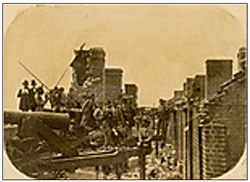 Perhaps
the most dramatic of the war's first photographic views is this study of
armed Confederate soldiers and top-hated civilians celebrating the
South's victory by draping themselves over the huge pivot guns that
Confederate Brigadier General Pierre G. T. Beauregard had silenced at
Fort Sumter. Given that Alma Pelot was a young studio portraitist with
little field experience, these modest-size prints with their rounded
corners and mature balance of architectural description and human
incident are extraordinary. Collectively they reveal a natural
understanding of the historical moment, a graphic appreciation for the
harsh beauty of a ruin, and an eye for the symbolic.
Perhaps
the most dramatic of the war's first photographic views is this study of
armed Confederate soldiers and top-hated civilians celebrating the
South's victory by draping themselves over the huge pivot guns that
Confederate Brigadier General Pierre G. T. Beauregard had silenced at
Fort Sumter. Given that Alma Pelot was a young studio portraitist with
little field experience, these modest-size prints with their rounded
corners and mature balance of architectural description and human
incident are extraordinary. Collectively they reveal a natural
understanding of the historical moment, a graphic appreciation for the
harsh beauty of a ruin, and an eye for the symbolic.
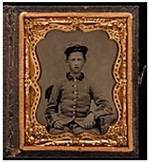 Private
Thomas Gaston Wood, Drummer, Company H, "Walton Infantry," Eleventh
Regiment Georgia Volunteer Infantry. Private Wood sits against a blank
wall in a photographer's studio. He is sixteen years old and will not
see seventeen. An orphan, he joined Company H in Social Circle, Georgia,
on July 3, 1861, and before the end of the year died of pneumonia in a
Richmond hospital. Wood seems proud of his shell jacket and especially
his kepi, which he marked under the brim with his initials. The
photographer tipped up the cap to reveal the sitter' s handiwork, but
the letters are laterally reversed in the tintype. As a musician, he
poses without any prop other than his uniform, the buttons touched with
gold.
Private
Thomas Gaston Wood, Drummer, Company H, "Walton Infantry," Eleventh
Regiment Georgia Volunteer Infantry. Private Wood sits against a blank
wall in a photographer's studio. He is sixteen years old and will not
see seventeen. An orphan, he joined Company H in Social Circle, Georgia,
on July 3, 1861, and before the end of the year died of pneumonia in a
Richmond hospital. Wood seems proud of his shell jacket and especially
his kepi, which he marked under the brim with his initials. The
photographer tipped up the cap to reveal the sitter' s handiwork, but
the letters are laterally reversed in the tintype. As a musician, he
poses without any prop other than his uniform, the buttons touched with
gold.
 Private
James House with Fighting Knife, Sixteenth Georgia Cavalry Battalion,
Army of Tennessee. This portrait of a cavalryman is an excellent example
of a well-armed Confederate soldier. House wears a slouch hat and a
checked battle shirt seen through the gaps in a modified woolen shell
jacket with tabbed button closures. He brandishes his fighting knife and
for quick use has half removed a pocket revolver from its belted
holster. Perhaps the most frightening weapons in House's personal
arsenal may be his focused stare and his set jaw.
Private
James House with Fighting Knife, Sixteenth Georgia Cavalry Battalion,
Army of Tennessee. This portrait of a cavalryman is an excellent example
of a well-armed Confederate soldier. House wears a slouch hat and a
checked battle shirt seen through the gaps in a modified woolen shell
jacket with tabbed button closures. He brandishes his fighting knife and
for quick use has half removed a pocket revolver from its belted
holster. Perhaps the most frightening weapons in House's personal
arsenal may be his focused stare and his set jaw.
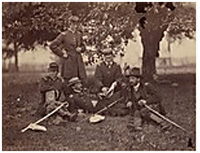 Without
a trace of irony, Major D. S. Ludlow (sitting on the ground) holds for
the camera a copy of the 1862 translation of The Art of War,
Antoine-Henri Jomini's definitive treatise on warfare and military
strategy, used as a standard reference by both Union and Confederate
generals. Military historians today believe that Baron de Jomini' s
outdated theories led to massive casualties during the Civil War.
Without
a trace of irony, Major D. S. Ludlow (sitting on the ground) holds for
the camera a copy of the 1862 translation of The Art of War,
Antoine-Henri Jomini's definitive treatise on warfare and military
strategy, used as a standard reference by both Union and Confederate
generals. Military historians today believe that Baron de Jomini' s
outdated theories led to massive casualties during the Civil War.
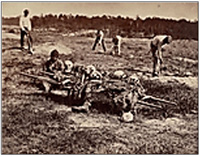 Few
photographs evoke the intense sadness of this picture. Corpses are being
collected by African American soldiers. Four soldiers with shovels work
in the background; in the foreground, a single laborer in a knit cap
sits crouched behind a bier that holds the lower right leg of a dead
combatant and five skulls—one for each member of the living work crew.
lt is a macabre and chilling portrait—literally a study of black and
white—that is as memorable as any made during the war.
Few
photographs evoke the intense sadness of this picture. Corpses are being
collected by African American soldiers. Four soldiers with shovels work
in the background; in the foreground, a single laborer in a knit cap
sits crouched behind a bier that holds the lower right leg of a dead
combatant and five skulls—one for each member of the living work crew.
lt is a macabre and chilling portrait—literally a study of black and
white—that is as memorable as any made during the war.
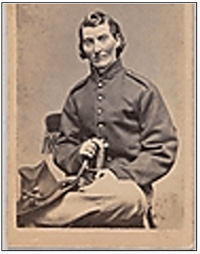 Frances
Clayton is an exception—a woman who served in the Union army by
disguising herself as a man. In a popular carte de visite
collected by soldiers at the end of the war, she poses here as Jack
Williams and suggestively holds the handle of a cavalry sword between
her crossed legs. The facts of her life story and military service are
difficult to confirm, but it is believed that she served in the Missouri
cavalry (or infantry) beside her husband, who died at the Battle of
Stones River in late December 1862.
Frances
Clayton is an exception—a woman who served in the Union army by
disguising herself as a man. In a popular carte de visite
collected by soldiers at the end of the war, she poses here as Jack
Williams and suggestively holds the handle of a cavalry sword between
her crossed legs. The facts of her life story and military service are
difficult to confirm, but it is believed that she served in the Missouri
cavalry (or infantry) beside her husband, who died at the Battle of
Stones River in late December 1862.
Editor’s note: 51 of the 200 photographs may be viewed at www. The Metropolitan Museum of Art / Photography and the Civil War/ Selected Highlights
Answers In"Quiz"ative
1. Jesse and Frank James, Cole and Jim Younger.
2. Charles R. Jennison (b. 6/6/1834, d. 6/21/1884). Court-martialed and convicted of "plundering" 6/23/1865 and dishonorably dismissed from the service. Promptly elected to the Kansas State Legislature in 1865 and 1867, and to the Kansas State Senate in 1872!
3. Bibles were printed only in the North and had to be smuggled South.
4. Army, Corps, Division, Brigade, Regiment or Brigade, Company.
5. Army (Maj. Gen. USA, Gen CSA), Corps (Maj. Gen. USA, Lt. Gen. CSA), Division (Maj. Gen.), Brigade (Brig. Gen.), Regiment or Battalion (Col.), Company (Capt.)
6. French.
7. Jefferson Davis. This broke a tradition previously adhered to by the US Post Office, that a person may be depicted on U.S. postage or currency only after death.
8. Railroad ties twisted to be unusable (see picture at right).
9. Gunboats paid for in whole or in part by ladies' "Gunboat Societies" in Southern cities
10. Derisive nickname for graduates of West Point Military Academy.
11. During the Revolutionary War, the term applied to British Loyalists. During the Civil War, supporters of the Confederacy derisively extended the term to Southern Unionists.
| 12. | 1–J | 3-O | 5–F | 7–C | 9–K |
| 2–A | 4–E | 6-D | 8–B | 10-I |
| 13. | 1 - August | 4 - May | 7 - April | 10 - September |
| 2 - October | 5 - February | 8– March | 11 - December | |
| 3 - January | 6–November | 9 - June | 12 - July | |
| 14. | 1 - False | 2 - False | 3 - False | 4 - True |
15. Derisive nickname for graduates of West Point Military Academy.
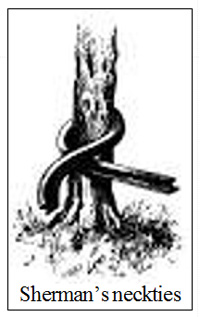
Last changed: 08/10/13